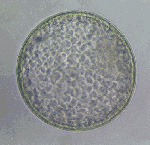 One of the advantages of embryo transfer is the ability to biopsy the embryos in an attempt to diagnose different genetic traits or determine gender. The ability to do so has existed for several years and the amount of genetic information that can be realized is ever expanding as geneticists learn more and tests become available to identify particular alleles.
One of the advantages of embryo transfer is the ability to biopsy the embryos in an attempt to diagnose different genetic traits or determine gender. The ability to do so has existed for several years and the amount of genetic information that can be realized is ever expanding as geneticists learn more and tests become available to identify particular alleles.
Embryo Biopsy Process
Embryos are generally flushed at seven or eight days after ovulation. Embryos this size can be biopsied with the use of an inverted microscope and micromanipulators; the same instrumentation that is used for in vitro fertilization. The tiny embryo is held in place with a suction pipette while the outer membranes (capsule and trophoblast) are pierced by the drill to retrieve cells from the embryo. These cells are then submitted to the laboratory for testing.
In order to better describe the timeline of this procedure the following events occur. The mare is flushed and the embryo identified. The biopsy process then takes less than an hour and the embryo is made ready for transfer and can be immediately transferred to the recipient mare. The cells harvested from the biopsy are packaged and sent to an appropriate laboratory for testing. The test results take several days to receive and the owner can then decide to continue with the pregnancy or terminate the pregnancy if the results are unfavorable. Or, in some cases, the owner may not terminate the pregnancy but simply be persuaded to try another embryo that may have a more desirable outcome for their breeding program. These decisions are often affected by the genetic trait(s) being tested for which could be something as ‘innocuous’ as gender or coat color or something as serious as fatal diseases such as cerebellar abiotrophy.
Another alternative to immediate transfer of the embryo is to freeze it. If the embryo is less than 300 µm it can be biopsied then frozen until the results of the test are complete. If the embryo is larger than 300 µm it can be biopsied, the blastocoel fluid aspirated to deflate the embryo and then frozen. Once the results of the biopsy are obtained the embryo can be transferred or remain in storage for future use.
Polymerase Chain Reaction (PCR) Testing
The testing done to identify a specific genetic trait is labeled a PCR test. PCR stands for polymerase chain reaction. PCR is a method which exponentially amplifies the DNA strands of the cells sampled so that there is enough genetic material present to identify certain alleles or small portions of the DNA carrying these traits. This test takes a few hours to conduct. PCR testing is becoming more widespread and is routinely used in veterinary medicine for disease identification and diagnosis. However, the PCR testing of embryonic cells that we are discussing is still only conducted in a few places, such as the University of California at Davis.
Conclusion
 Let me summarize some of this process if I can. Equine embryo biopsy is available to breeders currently. In order to biopsy embryos, the facility must have the equipment necessary. However, it is certainly feasible that the embryos could be shipped to such a facility and then biopsied and transferred there. There are no studies that show performing a biopsy is detrimental to the embryo and we feel at this time the transfer success rate (pregnancy rate) with biopsied embryos equals non-biopsied embryos. Currently, the PCR testing is done offsite. Thus, it is necessary to either transfer the embryo or freeze it before you get the result. This means you would have to terminate the pregnancy of a successful transfer if the results are unfavorable. An alternative would be to freeze the biopsied embryo which would allow waiting for results prior to transfer. The caveat here is that frozen embryos have a slightly reduced success rate compared to transferring fresh embryos (roughly 60% as compared to 80%).
Let me summarize some of this process if I can. Equine embryo biopsy is available to breeders currently. In order to biopsy embryos, the facility must have the equipment necessary. However, it is certainly feasible that the embryos could be shipped to such a facility and then biopsied and transferred there. There are no studies that show performing a biopsy is detrimental to the embryo and we feel at this time the transfer success rate (pregnancy rate) with biopsied embryos equals non-biopsied embryos. Currently, the PCR testing is done offsite. Thus, it is necessary to either transfer the embryo or freeze it before you get the result. This means you would have to terminate the pregnancy of a successful transfer if the results are unfavorable. An alternative would be to freeze the biopsied embryo which would allow waiting for results prior to transfer. The caveat here is that frozen embryos have a slightly reduced success rate compared to transferring fresh embryos (roughly 60% as compared to 80%).
As with so many things in our world today, the technology in this arena is changing rapidly. I envision the testing to become more simplified and widespread and the genetic traits we can test for to greatly expand. Today we may be looking at gender, coat color, HYPP and HERDA for example but tomorrow it may be heart size or other desirable athletic traits. The list is constantly expanding and the possibilities seem infinite.
See Also: Ways to Determine Fetal Gender





